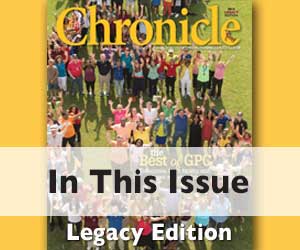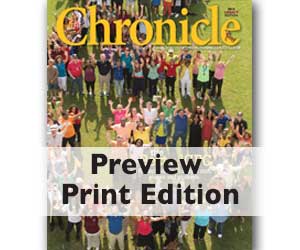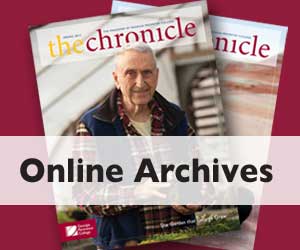by Stell Simonton
In the fall of 1964, DeKalb College first threw open its doors. It was a sparkling brick and glass campus in Clarkston, and it welcomed 763 students.
A buzz of change was in the air: The civil rights movement was in full swing, the Milwaukee Braves were moving to Atlanta, and the Beatles had just invaded American radio. The personal computer and Internet were undreamed of by most people.
Few could have predicted that 50 years later, the college would have five campuses, more than 21,000 students and an array of courses not known in 1964.
Georgia Perimeter College was originally the vision of DeKalb School Superintended Jim Cherry, who wanted a county school system that would educate its students from first grade through junior college. The college opened under the Georgia Junior College Act of 1958 and was the only public two-year college in Georgia supported and run by a local school board. It practiced open admission—requiring only a DeKalb high school diploma or equivalent.
The first branch campus opened in 1972 outside of Decatur. Seven years later, a north campus opened in Dunwoody. In 1986, the college joined the University System of Georgia. It was renamed Georgia Perimeter College in 1997. Since then it has opened an Alpharetta and a Newton County campus.
As GPC celebrates its 50th birthday this year, the question arises: What will colleges look like in another 50 years? In an era of major technological development and economic change, colleges are examining the directions they should take in the future.
Will teleconferencing, online courses and other digital technology transform the classroom? Will students be on flowing, individual schedules rather than on semesters?
“I have a hard time [imagining] further than about 20 years because I know that somewhere around there is a huge change happening that none of us can foresee,”said Sally Robertson, associate professor of Drama and Theatre at Georgia Perimeter.
Robertson is part of a University System of Georgia task force exploring massive open online courses (MOOCs) and additional new directions. More than 200 administrators, students, adult learners and others are participants in “Inventing the Beyond: Crowdsourcing the Future of Learning in 2030.”
But what about 2064?
“We will be highly technological, and I hope that we can adapt our teaching methods to use the technology to make us better teachers and the students better learners,”Robertson said. She finds the possibilities exciting.
Here is a sampling of views (local and national) on what the future may hold for higher education in general and for GPC:
Sally Robertson
Theatre Program Coordinator and Associate Professor
GPC Department of Fine Arts and Humanities
“I like to think of [GPC] still as an access institution. I don’t think that will change. I hope we will still be a real concrete link in our community… .
“One of the things I’ve been thinking about is hybrid education. For example [in the future], in my classroom of 25 students I could be talking to and communicating with them in real time …but also with another 50 or 100 students around the world watching and participating online at the same time. Then after that session is done, I have a number of students, maybe 100 or 200 or 1,000 who can watch what we did in that class and participate online and do all the work.
“Learner-centered education is the idea that students come to a college and take what they need. …Why not let the students design what they’re doing … ?
“That’s my idea of hybrid —mixing these different possibilities together.”
Sri Rajasekaran
Student Government Association President
GPC Newton Campus
“The college environment is likely to transform from being a traditional on-campus environment to an almost entirely online environment. MOOCs will definitely play a vital role in the future of education.
“I also expect that the advancements in technology will result in the development of more interactive online classroom environments that will give students a very real-life feel. Depending on the economic, political and social situations of that time, the cost of education is likely to vary—but I suppose it will be more affordable than it is now, thanks to technology.
“I think that students will be flowing on individual schedules because that will allow flexibility for both students and instructors. Since students will be doing their education online, I would expect that they would be working part time or even full time while doing so.
“… I think the colleges and universities across the nation will be interconnected, and each college/university is likely to be offering educational and other services to students of other colleges/universities.”
Rob Jenkins
Associate Professor of English
GPC Alpharetta Campus
“I see higher education becoming increasingly more stratified, just as K-12 education has long been stratified, with the “best and brightest”—that is, the future CEOs—attending top universities, a managerial class that gets to go to lesser state schools and a whole host of worker bees who are relegated to technical schools…I just don’t like a system that pigeon-holes people from the start, and that’s what I see happening.
“The beauty of comprehensive community colleges, America’s unique contribution to higher education, has always been not only that they incorporate both the ‘education’ and the ‘training’ functions on the same campus, but that they allow students to move freely back and forth between the two. Thus the students get to choose and not have the educational system choose for them, which leads to more personal freedom and economic mobility.
“Unfortunately, I’m afraid comprehensive community colleges (which we don’t have here in Georgia, in any case) are on their way out, taking that freedom and mobility for many students with them.”
Ursula Thomas
Director for Field Experience and Assessment
GPC’s Teacher Education Program
“Two-year institutions will continue to exist because of the nature of the students that we serve—students who are at a disadvantage, students who may not have had a positive experience in K-12.
“Also, two-year institutions are gateways to senior institutions. They are part of the gateway to the middle class, which is under attack right now. …We are a necessity. … The big question is: How should that necessity be funded?
“When we look at the big historical picture, and we look at where one of the pipelines is to a stronger economic position—especially for people of color, especially for women—the two-year institution is part of that solution.
Bill Gates
Co-Chair of the Bill and Melinda Gates Foundation
Co-Founder and Former CEO of Microsoft
“The value of MOOCs comes when you use them to create hybrids that are the best of both worlds. Rather than having the instructor lecture during class and then send the students home with assignments, many instructors are now using MOOCs to “flip the classroom.”
“In a course at Bunker Hill Community College, students watch lectures by MIT professors at home. Then they do assignments in class with the guidance of Bunker Hill faculty. Used this way, MOOCs increase the one-on-one time available between faculty and students.
“This may be the biggest untold story of education technology: When used properly, technology can amplify the human element in education.”
(excerpt from Oct. 2, 2013 speech to Association of Community College Trustees.)
Michael Haggans
Visiting Professor, Center for 21st Century Universities
Georgia Institute of Technology
“A range of institutions …are really vulnerable. …What I see happening is more and more of the content they’ve historically provided will go online. It’ll be less expensive. …
“Classrooms will be bigger, flatter and faster—and I believe there will be fewer of them. They’re bigger because people are moving around and doing group activities and they’re using tables.
“…People are viewing the classroom as a place to test and apply information, not just get information. The lecture portion is taking place someplace else…
“The activity that takes place in the classroom is an interactive process, and the physical consequences are that ‘tablet-arm chairs’and sloped floors don’t work anymore.
It’s faster in the sense that the bandwidth of the room is higher … .
“Because of the nature of those experiences …[students] will not need to come together as often. They may be spending just as much time devoted to the content of that work, but they won’t necessarily be there in the [traditional] classroom hour. Because of that scheduling flexibility, it will be possible for institutions to have fewer classrooms.
Dr. Di Xu
Postdoctoral Research Associate
Community College Research Center
Columbia University
“There will still be physical campuses and physical classrooms, but a lot of student work will be conducted online. Just like today, students who perform well online will be able to get a totally online degree. But my feeling is that it will still be a small proportion of the total degrees granted.
“Online provides flexibility to students—particularly adult learners—but there are some elements in face-to-face learning that can hardly be replaced entirely. …Online courses as typically designed today usually have student outcomes that are not as good as those in face-to-face courses. One concern is the quality of teaching and the quality of learning online.
“”…Physical campuses will still remain even in 50 years because people still value the immediate face-to-face experience … .
Students will be increasingly able to take courses from other colleges. It’s totally possible that a student can take a few courses from College A and then another set of courses from College B, but I’m not sure how those courses can be counted toward a particular degree.”
Marina Gorbis
Executive Director, Institute for the Future
Author of “The Nature of the Future”
“MOOCs today are our equivalents of early TV, when TV personalities looked and sounded like radio announcers (or often were radio announcers). People are thinking the same way about MOOCs, as replacements of traditional lectures or tutorials, but in online rather than physical settings.
“In the meantime, a whole slew of forces is driving a much larger transformation, breaking learning (and education overall) out of traditional institutional environments and embedding it in everyday settings and interactions, distributed across a wide set of platforms and tools. They include a rapidly growing and open content commons (Wikipedia is just one example), on-demand expertise and help (from Mac Forums to Fluther, Instructables, and WikiHow), mobile devices and geo-coded information that takes information into the physical world around us and makes it available any place any time, new work and social spaces that are, in fact, evolving as important learning spaces (TechShop, Meetups, hackathons, community labs).
“We are moving away from the model in which learning is organized around stable, usually hierarchical institutions (schools, colleges, universities) that, for better and worse, have served as the main gateways to education and social mobility. Replacing that model is a new system in which learning is best conceived of as a flow, where learning resources are not scarce but widely available, opportunities for learning are abundant, and learners increasingly have the ability to autonomously dip into and out of continuous learning flows.”
(Excerpt from Marina Gorbis’ article, “The Future Of Education Eliminates The Classroom, Because The World Is Your Class,” Co.Exist Futurist Forum.)
Arne Duncan
U.S. Secretary of Education
“I see two great challenges ahead.
First, community colleges need to better address the needs of older adults with little or no college experience who are finding it more and more difficult to find meaningful work in the information age … .
“Second, we need to systematically reorient the pre-K-16 system so that federal, state, district, and postsecondary programs to do more to support earning a degree or certificate… .
“What we need is for states to raise the bar; to set clear goals for community colleges based on more accurate measures of college completion.”
(Excerpt from 2010 speech at first White House Summit on Community Colleges.)
Dr. Paul Hudson
Professor of History
GPC Clarkston Campus
“I’m an optimist. I think our best years are ahead of us …I think the entire college [GPC] will be on the National Register of Historic Places for the post-modern architecture that we have …
“…What I see is that we will have even more teacher-scholars. We’re starting to have Fulbright fellows. We’re going to continue to have even more of an award-winning faculty that’s going to be known for scholarship as well as teaching.
“I see a really bright future for Georgia Perimeter College—but I don’t think we’ll ever have a football team.”


















No Comments on “College of the Future — Looking Ahead to 2064”